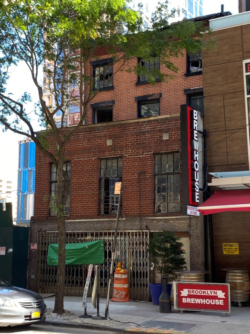
Harriet and Thomas Truesdell House Image Credit: LPC
LPC seeks to honor Brooklyn’s abolitionist history with Downtown Brooklyn landmark. On June 30, 2020, the Landmarks Preservation Commission voted to calendar the designation of the Harriet and Thomas Truesdell House located at 227 Duffield Street in Brooklyn. The property is situated in Downtown Brooklyn, between Willoughby Street and Fulton Street. The designation is sought to preserve the historical significance the Truesdells played into the pre-civil war abolitionist movement, having lived in their 227 Duffield home for more than a decade.
The Truesdell House was built around 1847 as Greek-Revival row house. The house was later altered to reflect early 20th-century changes in the neighborhood. The alterations include the removal of the front and rear porches and a two-story commercial extension in 1933. The remaining building above the extension retains its original 1850s façade, fenestration pattern, window surrounds and cornice. As stated by the Landmark’s staff, “the building’s form and historic fabric still convey its 19th century residential character and association with the Truesdells and Brooklyn’s significant abolitionist history.”
Thomas and Harriet Truesdell moved from Rhode Island to Brooklyn in 1838. Originally residing in Brooklyn Heights, the Truesdells moved to Duffield Street in 1851, where they lived until 1863.The house remained in the Truesdell family for seventy years, ultimately terminating in 1921.
Thomas Truesdell owned an import/export firm on Pearl Street in Manhattan and both him and his wife Harriet were actively involved in the abolitionist movement throughout their time in New England and New York. The Truesdells were confirmed associates of William Lloyd Garrison. Landmarks also reports that there were verbal accounts that the Truesdell House was a stop on the Underground Railroad. While the Landmarks staff could not confirm these accounts, the staff stated that housing fugitives was a dangerous and secretive activity, often making it hard to document or verify.
Brooklyn itself was an important region for the abolitionist movement. In the early 19th century, Brooklyn’s economy relied on the storing and export of agricultural products from the slave-holding southern states. The busy working waterfront evolved into an important point of entry for stowed-away freedom seekers. Many were then sheltered by local abolitionists until they either stayed in Brooklyn or traveled further north to places like Upstate New York, New England and even Canada. This designation comes in contemplation of this important part of African American history and heritage.
The calendaring was unanimously approved, without a shred of opposition, but the commission did briefly engage in discussion about the criteria for designating sites for their historical significance. Commission Chair Sarah Carroll candidly admitted that those standards were something that Landmarks, as a regulatory agency, “needed to grapple with.”
Carroll said the discussion would be far more intensive during the hearing phase, but did say that Landmarks has historically considered the following: the importance of the event, that the event be a “significant influence” or “game changer,” that the association is pivotal or for a long period of time, and that the condition of the building contain enough fabric or appearance that is associated with the significant event.
The public hearing for this application is scheduled for July 14, 2020 at 9:30 AM. You can watch the live-stream of the public hearing on Landmark’s Youtube channel. To be directed to that channel, click here.
By: Jason Rogovich (Jason Rogovich is the CityLaw Fellow and New York Law School Graduate, Class of 2019)

